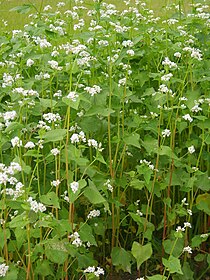荞麦
| 荞麦 | |
|---|---|

| |
| 《德意志、奥地利和瑞士植物志》 (1885), Fagopyrum esculentum | |
| 科学分类 | |
| 界: | 植物界 Plantae |
| 演化支: | 维管植物 Tracheophyta |
| 演化支: | 被子植物 Angiosperms |
| 演化支: | 真双子叶植物 Eudicots |
| 目: | 石竹目 Caryophyllales |
| 科: | 蓼科 Polygonaceae |
| 属: | 荞麦属 Fagopyrum |
| 种: | 荞麦 F. esculentum
|
| 二名法 | |
| Fagopyrum esculentum Moench
| |
| 异名[1] | |
| |

荞麦(学名:Fagopyrum esculentum,英语:buckwheat)亦作普通荞麦(common buckwheat)[2][3]以跟其他同属物种区别[4],是蓼科荞麦属的植物,也有人将其分入蓼属,它是一种双子叶植物。
普通荞麦和同属的苦荞麦(F. tataricum Gaertn)、金荞麦(F. dibotrys H.Hara),在汉语与英语均称“麦”(wheat),且都可作粮食,但与其他粮食作物不同的是,它们不属于禾本科。荞麦是从小野荞麦(Fagopyrum leptopodum)演化出来的,野生荞麦是一种藤本植物,而栽种的荞麦亚种的茎却是直立的。
荞麦种子呈三角形,被硬壳所包裹,去壳后可磨面食用。
种植
荞麦和苦荞麦一般认为起源于中国,尤其是西南部的四川、云南、西藏交界的地区,因为甜荞和苦荞的近缘野生种主要分布在这一地区。[5]然而通过化石和微化石(主要是花粉)硏究,发现最早可信的栽培甜荞出现在公元前5000多年的中国北部黄土高原地区。荞麦在公元前2000年之前已传到欧亚大陆各地,可能是通过喜马拉雅山南麓向西传到高加索地区及欧洲。 [6]

荞麦生长期短,可以在贫瘠的酸性土壤中生长,不需要过多的养分和氮素,但需要有充足的水分,下种晚,在比较凉爽的气候下开花。所以可以在受水灾以后作为补种,也可以作为绿肥、饲料或防止水土流失的覆盖植物。
普通荞麦占全世界种植荞麦的90%以上,主要种植荞麦的国家有俄罗斯、中国、日本、波兰、加拿大、巴西、南非和澳大利亚,美国种植荞麦在近些年已经锐减,1918年有4000平方千米,到1964年仅剩下200平方千米。
利用
食用

荞麦面粉比小麦面粉的颜色较深,法国人用于做黑面包;日本人做荞麦面,朝鲜人做一种凉糕,波兰人直接用未磨的去皮种子做粥,此外欧洲人还用来做粥或做淀粉使汤增稠。

发酵的荞麦面俄罗斯人做烙馅饼,法国人做小薄饼,有一种类似蘑菇的味道。
在四川、云南、贵州等地高寒山区居住的彝族居民将荞麦当作主食之一。彝族居民将荞麦区分为“甜荞”(彝文:ꈿꐎ)和“苦荞”(彝文:ꈵꆈ)两类,“甜荞”大致相当于中国大陆和日本等地普遍种稙的各类品种,而“苦荞”则是适应当地高寒气候的特殊品种。虽然“苦荞”有一定的苦味,但彝族人民向来非常喜爱。在彝语北部方言地区,一般婚礼上都会准备荞饼,当地汉族人称之为“荞粑粑”。据说必备荞饼的原因是当地彝语方言里“荞麦”和“思念”谐音(当地彝语称“荞麦”为[ŋgɤ˧],而“思念”的发音则为[ŋgɤ˧]或[ŋgu˧])。
荞麦还是一种蜜源植物。但荞麦的茎叶有毒,食用会造成荞麦中毒症,皮肤会对阳光过敏,尤其是浅色的牲畜和肤色浅的人反应更强烈,但其嫩芽无毒且营养丰富,芽菜族群食用它们的嫩芽“荞麦苗”。
种皮
荞麦种皮可以用于填充枕头和坐垫,荞麦皮比较坚固,不传热和反射热。尤其对那些对羽毛过敏的人,荞麦皮枕头比羽绒枕头要好,所以荞麦皮也作为一种商品买卖。现在正在研究荞麦皮枕头对人类健康的益处。
酿酒
近些年来用荞麦取代其他粮食来酿造啤酒,可以降低啤酒中的含糖蛋白量,生产“无糖蛋白啤酒”,适合对糖蛋白敏感的,患乳糜泻的人饮用。
冰淇淋
近年来有一些手工冰淇淋店,模仿一般冰淇淋的口感,使用荞麦制作出不含乳制品的荞麦冰淇淋,零胆固醇,热量较低,全素可食,属一种独特的冰品。
饮品
将苦荞进行加工后,可作为茶来饮用,被称为“苦荞茶”。味微苦,但十分香浓且廉价,在中国西南地区的小型餐厅中极受欢迎。
参考资料
- 粮食作物手册 (页面存档备份,存于互联网档案馆)
- Damania, A.B. 1998. "Diversity of Major Cultivated Plants Domesticated in the Near East".[1]
- Mazza, G. 1992. Buckwheat (Fagopyrum esculentum), the crop and its importance, p. 534-539. In: R. MacRae (ed.). Encyclopedia of food science, food technology and nutrition. Academic Press Ltd., London.
- Mazza, G. 1993. Storage, Processing, and Quality Aspects of Buckwheat Seed, p. 251-255. In: J. Janick and J.E. Simon (eds.), New crops. Wiley, New York.
- Marshall, H.G. and Y. Pomeranz. 1982. Buckwheat description, breeding, production and utilization, p. 157-212 In: Y. Pomeranz (ed.). Advances in cereal science and technology. Amer. Assoc. Cereal Chem., St. Paul, MN.
- McGregor, S.E. 1976. Insect Pollination Of Cultivated Crop Plants, chap. 9 Crop Plants and Exotic Plants. U.S. Department of Agriculture. As found on the website of the Carl Hayden Bee Research Center of the USDA Agricultural Research Service.[2]
参考文献
- ^ The Plant List: A Working List of All Plant Species. [3 October 2014]. (原始内容存档于2019-12-22).
- ^ Wang, Ya; Nie, Zihan; Ma, Tingjun. The Effects of Plasma-Activated Water Treatment on the Growth of Tartary Buckwheat Sprouts. Frontiers in Nutrition. 2022-02-24, 9: 849615. ISSN 2296-861X. PMC 8908094
 . PMID 35284468. doi:10.3389/fnut.2022.849615
. PMID 35284468. doi:10.3389/fnut.2022.849615  .
.
- ^ USDA GRIN Taxonomy. [16 December 2014]. (原始内容存档于2016-03-05).
- ^ 廖宜伦; 陈裕星; 林云康; 陈镮斌. 蕎麥芸香苷之研究. 台中區農業改良場一○一年專題討論專集 (PDF). 台湾行政院农业委员会台中区农业改良场. : 87–96 [2016-08-03]. (原始内容 (PDF)存档于2016年8月15日) (中文(繁体)).
- ^ Ohnishi, Ohmi. On the origin of cultivated buckwheat (PDF). Proceedings of the 9th International Symposium on Buckwheat. Prague. 2004 [2019-08-12]. (原始内容存档 (PDF)于2020-10-05).
- ^ Hunt, Harriet V.; Shang, Xue; Jone, Martin K. Buckwheat: a crop from outside the major Chinese domestication centres? A review of the archaeobotanical, palynological and genetic evidence. Vegetation History and Archaeobotany. 2018, 27 (3): 493–506 [2017-12-02]. doi:10.1007/s00334-017-0649-4. (原始内容存档于2018-06-16).
延伸阅读
[在维基数据编辑]
外部链接
- 荞麦的营养成分 (页面存档备份,存于互联网档案馆)
- glutenfreebeerfestival.com - 用荞麦制造麦芽糖 (页面存档备份,存于互联网档案馆)
- 荞麦, Qiaomai (页面存档备份,存于互联网档案馆) 药用植物图像数据库 (香港浸会大学中医药学院) (繁体中文)(英文)
- 荞麦 Qiao Mai (页面存档备份,存于互联网档案馆) 中药标本数据库 (香港浸会大学中医药学院) (繁体中文)(英文)
- http://www.htbuckwheat.com (页面存档备份,存于互联网档案馆) 中国最大最专业苦荞生产商四川环太
| |||||||||||||||||||||||||||||||||||||||||||||||||||||||||
| ||||||||||||
|
Text is available under the CC BY-SA 4.0 license; additional terms may apply.
Images, videos and audio are available under their respective licenses.


